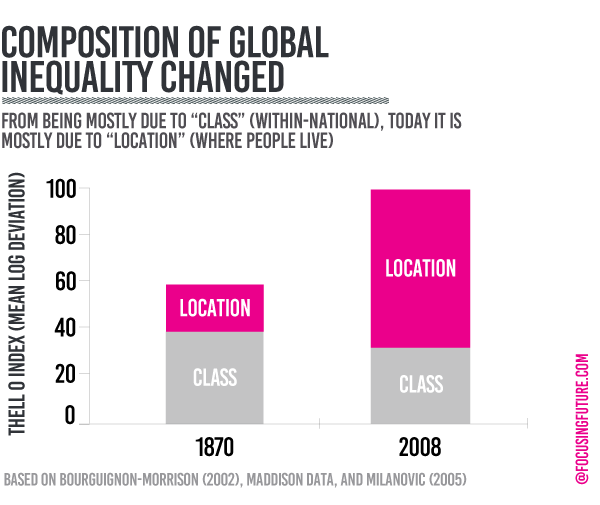![]() 6 minute read
6 minute read
People are born in unequal circumstances. Everything from location, gender, and race differentiate child’s opportunities in life. However, today’s ability to gather and analyse the data should help communities to fix and prevent inequalities. This article presents layers of inequalities and its outcomes.
Geographical
impact
Global inequality, the first time since the industrial revolution, has ceased to increase. However, that does not indicate that the world is wholly less unequal. In fact, in the globalized setting of today, inequality has moved from individual to state level. Branco Milanovic, the author of ‘Global Inequality: A New Approach for the Age of Globalization’, terms the transition as a move from class inequality to location inequality. People born in rich countries are born with a ‘citizen premium’ and hence have a higher wage as compared to people belonging to the same occupational level in a poor country. According to a UNESCO report, the per capita income gap between the world’s richest and the poorest countries today is as large as it has ever been. This, in turn, leads to a world where the widest gaps in living standards have less to do with socio-economic issues or status levels and more to do with location.

Similarly, the citizenship premium negates any form of global equality of opportunities which become one of the leading factors of migration. In that regard, it is essential to target equality at both global levels as well as within the state system too. If the two are not taken together, global economy might reduce as developing countries catch up to developed countries but that would not translate into better lives for the people of the country. Such a scenario will naturally lead to great internal rest within countries and might make some states unstable transitioning from social inequalities to eventually geographic inequalities.
The rural-urban divide is another aspect of inequality. A study of 65 countries conducted by Alwyn Young of London School of Economics found that up to 40% of mean country inequality was due to the rural-urban gap. Another study conducted by UN/WIDER found that the gap was most drastic in low-income countries and as countries reach the upper-middle income level, the gaps start shrinking. The said gap is another example where there is a difference in the opportunities available to people in different geographical settings. Any measure to curb the spread of inequality will have to be mitigate these divides as well.
Race
still matters
Inequality of opportunities can be best reflected in societies where different races exist and are divided into culturally segregated social circles. This segregation dictates the sort of opportunities available to people belonging to different ethnic backgrounds, hence impacting how they will prosper in comparison to those who belong to a privileged race. This is further exacerbated due to the proportion of privileged and unprivileged. For example, a poll conducted by PEW research centre found out that the white-skinned American population and the dark-skinned American population had different understandings of the degree of racism in the country. More importantly, each had different views on how the issue of racism could be addressed and how much attention of the state was required on it. For example, only 11% of the white-skinned Americans were hopeless about the State implementing policies to curb racism. In contrast, a mammoth 43% of dark-skinned respondents claimed that America will not make changes needed to give ‘blacks equal rights with whites’.
International
migration

The same discrepancy in views can be expected amongst migrants. Migrants will form a considerable proportion of the world’s global population in the near future. According to PEW research, by 2050, there will be 71 million Muslims living in Europe alone. This considerably large populace changes the social landscape of Europe and requires to be seen through the lens of racial and immigrant inequality. This is reflected in the differences of employment rates in countries that have a considerable minority population. In the UK, for example, there is a jobless rate of 45% amongst migrants as compared to the 19% for natives. Such inequalities, also influence the potential for generational changes in economic classes. As migrants have fewer possibilities available to them, they are destined to be, what Peniel Joseph, a professor of history and director of the Center for the Study of Race and Democracy at Tuft, calls as ‘uneven citizens’. According to Joseph, ‘It’s connected to education, civil institutions … and even universities’. People hence, living as segregated, tend to have lesser opportunities to jump their social classes. The UN Chronicle noting the apparent racial inequality has urged countries to do more than just ‘existing on paper’. It notes that the implementation bodies need to be stricter in imposing precedents which will impede such social attitudes.[nbsp]Such measures will ensure that racial bias in the society is decreased and with time, the community becomes more equal in terms of opportunities.
Inequality
in Education
General inequality also translates into inequality in Education. Harvard Political Scientist, Robert Putnam recognizes this stating that the ‘opportunity gap imposes…real costs and what economists term opportunity costs’. Hence, the gap in opportunities between the different populations has repercussions beyond the first generation. Developed countries are more educated than developing ones. According to OECD measures, inequality is at its highest level in 30 years. In Europe alone, for example, Turkey has a population of over 10% with no formal education as compared to Norway with 0.2%. Disadvantaged students are 3 times more likely to be amongst PISA performers.

At the same time, this disparity leads to various levels of development at national level. For example, the most technologically advanced countries today either have a large proportion of educated nationals or are a migrant hub for similar brain drains. Hence, countries that are least educated, divert their manpower to less technological industries such as agriculture. In retrospect, these developed countries make the developing countries dependent on them due to the inescapable demand for technology.




